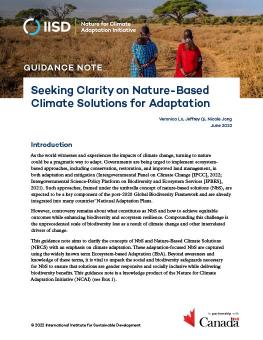
Seeking Clarity on Nature-Based Climate Solutions for Adaptation
While there is increasing policy momentum for NbS, criticisms and controversy cloud its application and upscaling. This guidance note clarifies the concepts behind NbS and related terms and shines a light on how to achieve equitable outcomes through a focus on gender responsiveness, social inclusion, and positive outcomes for biodiversity and ecosystems.
-
The Nature for Climate Adaptation Initiative will strengthen the knowledge and capacity of civil society organizations through an e-learning course, a virtual library of resources, and targeted online and in-person learning exchanges.
-
Nature-based climate solutions have the potential to deliver measurable benefits to communities and ecosystems in cost-effective, equitable ways.
-
Implementing nature-based climate solutions with strong social inclusion principles and robust social environmental safeguards with adequate enforcement can enhance their efficacy and legitimacy while enhancing biodiversity and ecosystems.
As the world witnesses and experiences the impacts of climate change, turning to nature could be a pragmatic way to adapt. Governments are being urged to implement ecosystem-based approaches, which include conservation, restoration, and improved land management, in both adaptation and mitigation. Such approaches, framed under the umbrella concept of nature-based solutions (NbS), are expected to be a key component of the post-2020 Global Biodiversity Framework and are already integrated into many countries’ National Adaptation Plans (NAPs).
However, controversy remains about what constitutes as NbS and how to achieve equitable outcomes while enhancing biodiversity and ecosystem resilience. Compounding this challenge is the unprecedented scale of biodiversity loss as a result of climate change and other interrelated drivers of change.
This guidance note aims to clarify the concepts of NbS and nature-based climate solutions (NBCS) with an emphasis on climate adaptation. These adaptation-focused NbS are captured using the widely known term ecosystem-based adaptation (EbA). Beyond awareness and knowledge of these terms, it is vital to unpack the social and biodiversity safeguards necessary for NbS to ensure that solutions are gender responsive, socially inclusive, and deliver biodiversity benefits. This guidance note is a knowledge product of the Nature for Climate Adaptation Initiative (NCAI).
Participating experts
You might also be interested in
How Can We Work With Nature to Tackle Drought and Desertification?
Drought is one of the most devastating and pervasive challenges exacerbated by climate change. However, we can work to reduce its effects through nature-based solutions for land restoration and climate-smart agriculture.
IISD Annual Report 2023–2024
While IISD's reputation as a convenor, a trusted thought leader, and a go-to source on key issues within the sustainable development field is stronger than ever, the work happening outside the spotlight is just as valuable.
For Nature-Based Solutions to Be Effective, We Need to Work with Indigenous Peoples and Local Communities
Nature-based solutions have been praised as a promising approach to tackling the twin crises of climate change and biodiversity loss. But some Indigenous Peoples and local communities are questioning the legitimacy of the concept and what it symbolizes. It is time to listen to what they have to say.
Mainstreaming Gender Equality and Social Inclusion in Nature-Based Solutions for Climate Change Adaptation
Discover tools, recommendations, and case studies on how to plan, design, and implement nature-based solutions for adaptation that advance gender equality and social inclusion while enhancing resilience, biodiversity, and ecosystem integrity.
